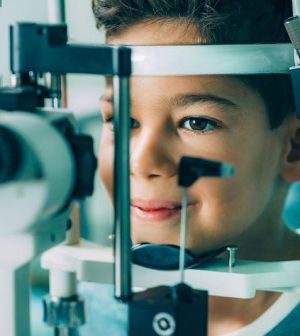- Navigating Your Midlife Crisis: Embracing New Possibilities
- City Raccoons Showing Signs of Domestication
- Mapping the Exposome: Science Broadens Focus to Environmental Disease Triggers
- One Week Less on Social Media Linked to Better Mental Health
- Your Brain Changes in Stages as You Age, Study Finds
- Some Suicide Victims Show No Typical Warning Signs, Study Finds
- ByHeart Formula Faces Lawsuits After Babies Sickened With Botulism
- Switch to Vegan Diet Could Cut Your Greenhouse Gas Emissions in Half
- Regular Bedtime Does Wonders for Blood Pressure
- Dining Alone Could Mean Worse Nutrition for Seniors
Could ‘Lazy Eye’ in Childhood Raise Risks for Adult Disease?

Children with “lazy eye” are more likely to become adults facing an array of serious health problems, a new study warns.
Kids diagnosed with amblyopia are more likely to develop high blood pressure, obesity and diabetes as adults, researchers found.
They also face an increased risk of heart attack, according to findings published March 7 in the journal eClinicalMedicine.
“Vision and the eyes are sentinels for overall health,” said lead author Dr. Siegfried Wagner, a senior research fellow with the University College London Institute of Ophthalmology. “They are intimately linked with other organ systems. This is one of the reasons why we screen for good vision in both eyes.”
Amblyopia occurs when vision in one eye doesn’t develop properly. As the brain ignores the weaker eye, that eye drifts out of position and tends to face slightly away from wherever a person is looking.
As many as four in every 100 children have lazy eye, researchers said in background notes. It’s the most common vision condition in children.
For this study, researcher analyzed data from more than 126,000 people ages 40 to 69 participating in the ongoing UK Biobank study.
As part of their medical history, participants were asked whether they were treated for amblyopia in childhood, and whether they still had the condition in adulthood. They also were asked if they had been diagnosed with a series of other chronic health conditions.
Among more than 3,200 people who reported having lazy eye as a child, 82% still had persistent reduced vision in one eye as an adult, researchers found.
Adults who had amblyopia as a child also had a 29% higher odds of developing diabetes, a 25% increased risk of high blood pressure and a 16% higher risk of being obese.
Increased risk for health problems was found both in adults whose vision problems persisted and in those with perfect vision as an adult.
“It is rare to have a ‘marker’ in childhood that is associated with increased risk of serious disease in adult life, and also one that is measured and known for every child,” said researcher Jugnoo Rahi, a professor of ophthalmic epidemiology with the University College London Institute of Ophthalmology.
Wagner emphasized that the new study does not prove that lazy eye directly causes health problems later in life.
“Our research means that the ‘average’ adult who had amblyopia as a child is more likely to develop these disorders than the ‘average’ adult who did not have amblyopia,” Wagner said in a university news release. “The findings don’t mean that every child with amblyopia will inevitably develop cardiometabolic disorders in adult life.”
More information
The Cleveland Clinic has more about amblyopia.
SOURCE: University College London, news release, March 7, 2024
Source: HealthDay
Copyright © 2025 HealthDay. All rights reserved.










